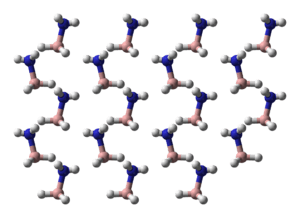Ammonia borane
Ammonia borane (also systematically named amminetrihydridoboron), also called borazane, is the chemical compound with the formula H3NBH3. The colourless or white solid is the simplest molecular boron-nitrogen-hydride compound. It has attracted attention as a source of hydrogen fuel, but is otherwise primarily of academic interest.
 | |
| Names | |
|---|---|
| IUPAC name
Ammoniotrihydroborate | |
| Other names
Borazane | |
| Identifiers | |
3D model (JSmol) |
|
| ChemSpider | |
| ECHA InfoCard | 100.170.890 |
| EC Number |
|
PubChem CID |
|
| UNII | |
CompTox Dashboard (EPA) |
|
| |
| |
| Properties | |
| BNH 6 | |
| Molar mass | 30.865 g mol−1 |
| Appearance | Colorless crystals |
| Density | 780 mg mL−1 |
| Melting point | 104 °C (219 °F; 377 K) |
| Structure | |
| I4mm, tetragonal | |
| Tetragonal at B and N | |
| Tetrahydral at B and N | |
| 5.2 D | |
| Hazards | |
| GHS pictograms |   |
| GHS Signal word | Danger |
| Related compounds | |
Related compounds |
|
Except where otherwise noted, data are given for materials in their standard state (at 25 °C [77 °F], 100 kPa). | |
| Infobox references | |
Synthesis
Reaction of diborane with ammonia mainly gives the diammoniate salt [H2B(NH3)2]+(BH4)−. Ammonia borane is the main product when an adduct of borane is employed in place of diborane:[1]
- BH3(THF) + NH3 → BH3NH3 + THF
Properties and structure
The molecule adopts a structure like ethane, with which it is isoelectronic. The B−N distance is 1.58(2) Å. The B−H and N−H distances are 1.15 and 0.96 Å, respectively. Its similarity to ethane is tenuous since ammonia borane is a solid and ethane is a gas: their melting points differing by 284 °C. This difference is consistent with the highly polar nature of ammonia borane. The H atoms attached to boron are hydridic and those attached to nitrogen are somewhat acidic.

The structure of the solid indicates a close association of the NH and the BH centers. The closest H−H distance is 1.990 Å, which can be compared with the H−H bonding distance of 0.74 Å. This interaction is called a dihydrogen bond.[2][3] The original crystallographic analysis of this compound reversed the assignments of B and N. The updated structure was arrived at with improved data using the technique of neutron diffraction that allowed the hydrogen atoms to be located with greater precision.

Uses
Ammonia borane has been suggested as a storage medium for hydrogen, e.g. for when the gas is used to fuel motor vehicles. It can be made to release hydrogen on heating, being polymerized first to (NH2BH2)n, then to (NHBH)n,[4] which ultimately decomposes to boron nitride (BN) at temperatures above 1000oC.[5] It is more hydrogen-dense than liquid hydrogen and also able to exist at normal temperatures and pressures.[6]
Ammonia borane finds some use in organic synthesis as an air-stable derivative of diborane.[7]
Analogous amine-boranes
Many analogues have been prepared from primary, secondary, and even tertiary amines:
- Borane tert-butylamine (tBuNH2→BH3)
- Borane trimethylamine (Me3N→BH3)
- Borane isopropylamine (iPrNH2→BH3)
The first amine adduct of borane was derived from trimethylamine. Borane tert-butylamine complex is prepared by the reaction of sodium borohydride with t-butylammonium chloride. Generally adduct are more robust with more basic amines. Variations are also possible for the boron component, although primary and secondary boranes are less common.[8]
Additionally, many complexes of borane have been prepared, including borane dimethylsulfide (Me2S→BH3) and borane–tetrahydrofuran (THF→BH3).
References
- Shore, S. G.; Boddeker, K. W. (1964). "Large Scale Synthesis of H2B(NH3)2+BH4− and H3NBH3". Inorganic Chemistry. 3 (6): 914–915. doi:10.1021/ic50016a038.
- Klooster, W. T.; Koetzle, T. F.; Siegbahn, P. E. M.; Richardson, T. B.; Crabtree, R. H. (1999). "Study of the N−H···H−B Dihydrogen Bond Including the Crystal Structure of BH3NH3 by Neutron Diffraction". Journal of the American Chemical Society. 121 (27): 6337–6343. doi:10.1021/ja9825332.
- Boese, R.; Niederprüm, N.; Bläser, D. (1992). Maksic, Z. B.; Eckert-Masic, M. (eds.). Molecules in Natural Science and Medicine. Chichester, England: Ellis Horwood. ISBN 978-0135615980.
- Gutowski, M.; Autrey, T. (2006). "Features: Hydrogen gets onboard". Chemistry World. 3 (3).
- Frueh, S.; Kellett, R.; Mallery, C.; Molter; T.; Willis, W. S.; King'ondu, C.; Suib, S. L. (2011). "Pyrolytic Decomposition of Ammonia Borane to Boron Nitride". Inorganic Chemistry. 50 (3): 783–792. doi:10.1021/ic101020k. PMID 21182274.
- Stephens, F. H.; Pons, V.; Baker, R. T. (2007). "Ammonia–Borane: The Hydrogen Source par excellence?". Dalton Transactions. 2007 (25): 2613–2626. doi:10.1039/b703053c. PMID 17576485.
- Andrews, Glenn C.; Neelamkavil, Santhosh F. (2008). "Borane–Ammonia". In Paquette, Leo A. (ed.). Encyclopedia of Reagents for Organic Synthesis. New York: John Wiley & Sons. doi:10.1002/047084289X.rb238.pub2. ISBN 0471936235.
- Staubitz, Anne; Robertson, Alasdair P. M.; Manners, Ian (2010). "Ammonia-Borane and Related Compounds as Dihydrogen Sources". Chemical Reviews. 110 (7): 4079–4124. doi:10.1021/cr100088b. PMID 20672860.